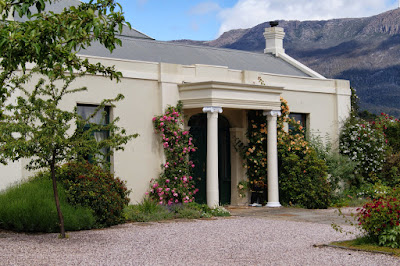The interest lies in the fact that it wasn’t. It originally was part of Dr W.Giblins residence at 142 Macquarie Street and was saved when that building was demolished in the 1950’s. But the charm of Islington is founded on more than Dr. Giblin’s porch. It is one of the few examples or Regency style architecture in Hobart and was built in 1845 for Mrs. Sarah Hodgson – a woman who achieved much (mainly through marrying wisely) despite the fact that both of her parents had been transported separately as convicts.
Sarah, whose father, George Guest, was the first man to introduce sheep into Van Diemen’s Land, first married a prosperous surgeon, merchant and ship owner, Thomas Birch in September 1808. One of Birch’s men, Captain James Kelly, discovered Macquarie Harbor on Tasmania’s west coast and named Sarah Island in honour of his employer’s wife.
After 13 years of marriage, her husband died, leaving her a relatively young and wealthy widow and some time later, she married his secretary, Edmund Hodgson. Although she built one of the finest houses in the colony, it appears that Sarah Hodgson never lived at Islington. The first tenant was E.J Manly, a senior government official who was both a foundation and committee member of the Tasmania Club, a trustee of St. David’s Church and the man entrusted by Governor Arthur to manage his property in the colony after he left.
When Sarah Hodgson died in 1868, her husband, Edmund, became the owner of Islington and 14 years later, he sold the property to the Misses Parsons. It would once again become the property of spinster sisters when in 1895, it was bought by the Misses Harvey – sisters of David Hastie Harvey who successfully managed Tattersalls for George Adams. The sisters named Islington after their home suburb in London.
Stepping into the front hall of Islington confirms the initial impression of dignified colonial grandeur and yet the feeling of the place essentially being a home is always present. The hallway is broad and long and the first few metres are paved in starkly contrasting black & white tiles. The next thing you notice is the extensive use of cedar in the doors and doorways. Wall and ceiling colours here, and in adjoining rooms are warm and the whole property is kept in a pristine condition.
Main Text & Information source:
“Mansions, Cottages and All Saints” – Book by Audrey Holiday & Walter Eastman
Islington Hotel
website:









